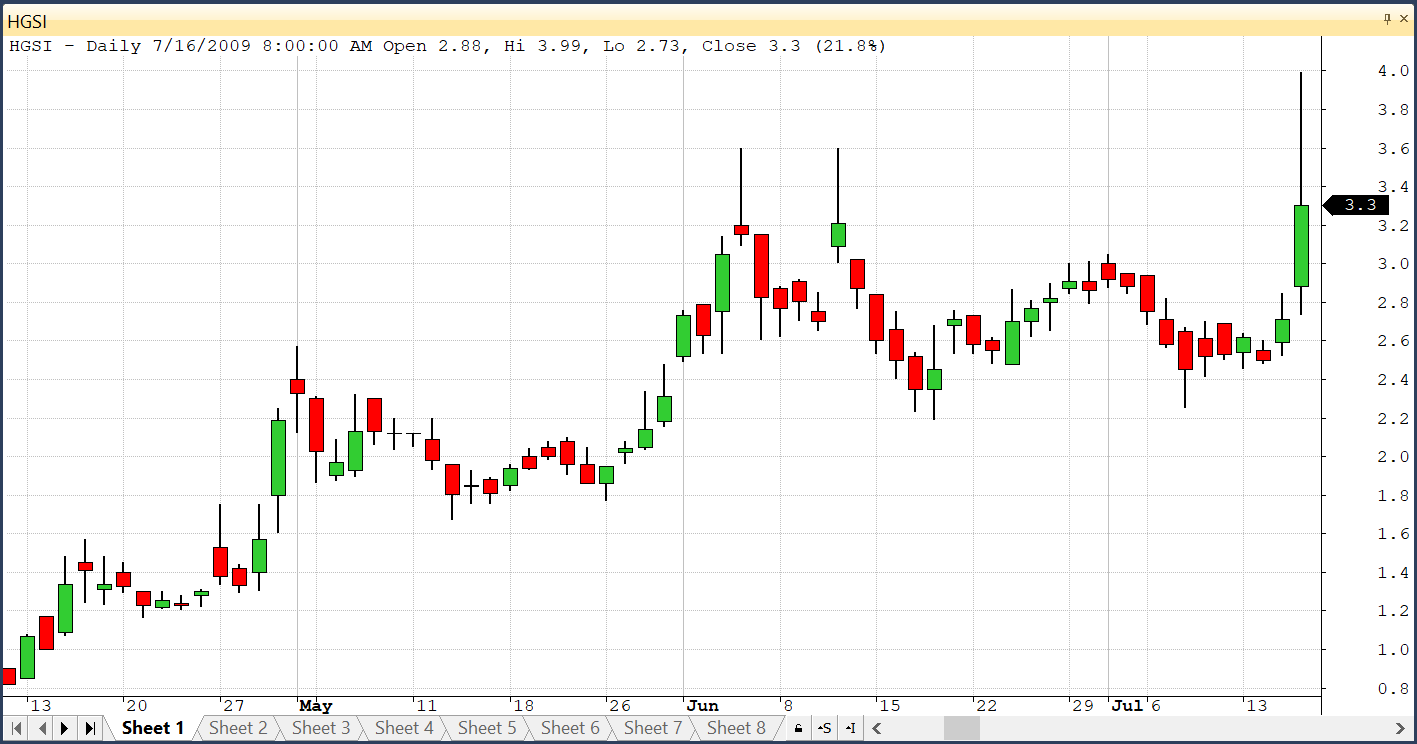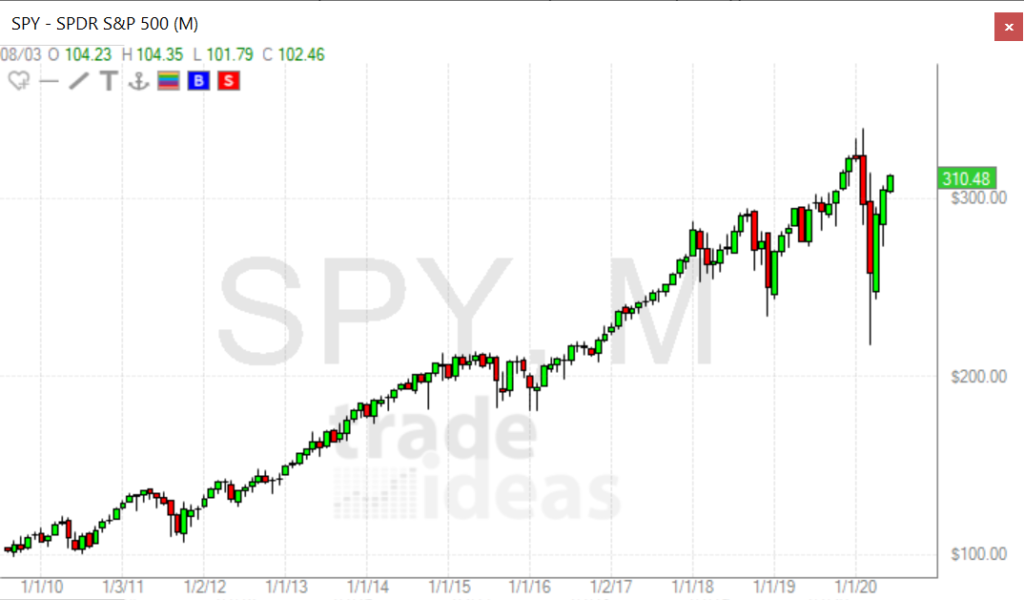Is it better to Day Trade or Swing Trade? This is one of those eternal questions that every trader has an opinion on. I’ve thought about this a lot over the years and heard a lot of traders opine about it. There are a lot of reasons to choose one or the other, but I think a lot of it boils down to your initial reaction when you see a chart like this:

Is your initial gut reaction one of hope and optimism that you could be on the right side of this overnight gap when it occurs? Or do you bristle with fear at the thought of being on the wrong end of this when you open your trading screens in the morning? (Personally, it makes me terrified and for a very good reason…)
What is Day Trading?
The definition of day trading is really very simple: when you end you’re trading day your account is 100% cash. There might be a whole variety of trades that happen throughout the day for all sorts of different reasons, but you’re only day trading if you’re flat at the end of the day by design.
What is Swing Trading?
Swing trading is taking trades with the intent of capturing at least one overnight move. The intended hold time can be just one day or many days. What if you’re intending to hold for a year? Is that a swing trade? No that’s an “investment”, though there is no real cutoff for when a “swing trade” held long enough becomes an “investment.”
Swing Trading Pros/Cons
More time to capture the move
Since you’re aiming to hold at least one overnight, you’ll be in these trades for a lot more time than a day trade. Sometimes you’re looking for an explosive move and you might be right about the direction of a trade but wrong about the timing. Swing trading gives your trades more of a chance to capture that move that you’re anticipating.
Capture the overnight gaps – for better or worse!
Since you’ll be holding overnight there’s a chance you’ll be riding some really profitable overnight gaps. Of course, these gaps can go against you but if you’ve done your homework you should be on the winning side of most of these gaps in the long run. This is the main advantage and in fact the entire point of swing trading. The overnight gaps are hard for a lot of traders to handle though.
Take advantage of the overall market long bias

One glance at a chart of the SPY for the last decade and it’s not hard to recognize that there’s a general long bias in the stock market. Swing trading allows you the opportunity to capture some of that natural drift upward.
Less buying power available
You’ll get less buying power even at full margin when swing trading. This could be a positive but I view it as a negative since I try to efficiently use my buying power.
Day Trading Pros/Cons
(If you know me well enough you’ll know that I feel pretty strongly that day trading is superior at least for my situation. I’m going to list one con and then the rest are overwhelming pros.)
Small accounts in the US are pretty much out of luck
If your account is less than $25k and you’re in the US, your day trading options are very limited due to the Pattern Day Trader rule or PDT (you know, for your own good). It can be done but it’s definitely a hassle. If this is the case then the scales tip strongly in favor of swing trading.
More buying power via day trading
If you’re interested in optimizing your buying power, then there’s no argument here: day trading wins hands down. You get twice the buying power from your broker trading intraday than you can hold positions overnight for swing trading.
Get paid on overnight interest versus paying the broker for margin
Not only do you get more buying power, but you essentially get paid to use it versus having to pay interest on margin balances held overnight. When you use margin overnight, you have to pay interest on it. Brokerages compete on that interest rate. It currently ranges from just under 2% (Interactive Brokers) to well over 9% (TD Ameritrade). Again this is the rate that you pay your broker for the privilege of holding overnight using margin.
When you are 100% cash each night (day trading) you get paid interest on your cash balance, like a checking or savings account. Now, the interest rate you get paid isn’t what it used to be. When I started trading years ago with a broker called CyberTrader, I was getting paid over 5% on the balance. Today’s interest rates are, of course, much less than that. If you check your statements, though, you’ll see that it’s not zero.
A friend of mine told me the other day: “There are two types of people in the world, those who pay interest and those who get paid interest.”

As a cycling enthusiast, there’s a good analogy here. Day trading is like riding with a slight tailwind while swing trading is like riding with an annoying headwind. You can ride fast with either a headwind or a tailwind, but the longer you ride the more and more the direction of the wind will add up. Over even a single ride of a few miles, this can be the difference in many minutes of time. For a visualization of how substantial this is, here’s a video of a cyclist using a position that very efficiently cuts through the wind.
Your trading account is similar. The difference might not be substantial for a single day or a few days, but over the long run, this will add up to something significant. That’s one reason I choose to trade with a tailwind instead of a headwind.
News comes out overnight
Most of the time the substantial news items that will drastically affect the price of stocks you’re holding are released outside of the trading day. Of course, this is not always true, but when news (or a certain politically powerful person’s tweets) come out during the trading day there will typically be far more liquidity available to react.
When news is usually released there will be little to no liquidity available, so if you need to get out of a trade you literally will not have that choice.
Freedom to take the day off on a whim
This is one of the huge benefits for me for day trading. Since you’re 100% cash at the beginning of every day by design, you can literally just take any day off whenever something comes up. This is extremely liberating as often things in life come up that take your attention away from the market. If you’re holding positions overnight you’ll have far less freedom to make last-minute adjustments to your schedule.
You’ll also just sleep better knowing you’re in cash and not holding a large position where news has just been released and wondering if you’re going to be on the right side of a big impending gap up or down.
Longer the timeframe, the less predictive a model will be
The longer your hold time, the more risk you’re taking. Your money is only at risk when you’re holding a position. Anything can happen. The stock can be halted, news can come out, any number of substantial (albeit unlikely) events can occur. The longer your hold time the more likely you are to experience one of these events.
When you’re trading a system, this means that the longer the hold time the less predictive the model will be over a large number of trades. Trading is essentially predicting the future and it turns out that’s really hard. There’s enough uncertainty within the trading day, but when you hold overnight that uncertainty is multiplied many times over.
It’s easier to short intraday
As I mentioned above, the market has a long bias when you zoom out to a large enough timeframe. This means that the longer your timeframe the easier it will be to trade a long strategy, but the harder it will be to use a short strategy. Selling short is scary for a lot of new traders but I know many short-term trader who make the vast majority of their profits trading short. There’s an old expression: stocks take the stairs up but the elevator down. Successful traders understand this.
By limiting yourself to swing trading, you’re giving yourself fewer chances to trade strategies that sell short.
Day trading is finite, swing trades can turn infinite
We all have heard this very typical scenario for beginning trades: they enter a trade for one reason, the stock goes against them, and then that reason evolves into “I’m holding this as an investment.” There’s a strong tendency in humans to want to be right – to sell at a profit even if the numbers say that’s the least long-term profitable thing to do.
With day trading, you have a natural limit on the amount of time you can hold a trade: the end of the trading day. You can’t talk yourself into turning a “trade” into an “investment” since you need to exit before the market closes. Day trading enforces this discipline in your trading.
The market will give you feedback more quickly
The shorter your timeframe the more quickly you can get valuable feedback from the market. If your trades take 5 days to play out (swing trading) versus 5 hours (day trading) then by definition you are going to get a lot of feedback much more quickly than swing trading. Over the course of just a month, this can be many, many more trades taken – all of which are learning opportunities. How fast do you want to learn?
The math is different now – commissions are zero
When I made my first trade I think I paid about $10 per side. Even at that point commissions had dropped dramatically but now they’ve literally dropped to zero at all the major brokerages. I remember telling people I day traded and they’d say “I bet you’re broker likes you!” With commissions at zero now that math looks substantially better when compared to swing trading. Does that mean your total trading costs are zero? Not by a long shot. I still pay my normal rate at Interactive Brokers for a variety of reasons, one of which is I feel like I’m getting what I pay for.
So although commissions are free, those costs are still born by you in some way – they’re just harder to see. But there’s little doubt that total trading costs have also gone down in this recent industry shift. Another reason to day trade versus swing trade – the math keeps getting easier.
Which is more profitable? Has to be day trading
Your goal as a trader should be to find a profitable system (preferably more than one) and trade it as often as possible. The smaller the timeframe the more trades you’ll be able to make with the buying power you have. This coupled with the fact that you’ll have access to more buying power, it’s easy to see that day trading has the potential to be far more profitable.
Can you think of other good reasons that should be added to the list? Contact me on Twitter.
